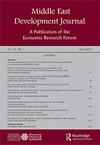Monetary policy in times of uncertainties: evidence from Tunisia, Egypt and Morocco
IF 0.8
Q4 DEVELOPMENT STUDIES
引用次数: 1
Abstract
ABSTRACT This study assesses the actual monetary policy stance in three countries in the MENA region, namely, Tunisia (between 2000 and 2017) and Egypt and Morocco (between 2007 and 2017), based on the Taylor rule framework. Especially, it explores the impact of transition periods and high uncertainties following the so-called Arab Spring on the central bank decision-making process. The results provide no strong evidence in favor of rule-based monetary strategies on the part of the central banks in these countries, which still largely rely on discretion when deciding their policy rates. Nevertheless, they show a remarkable presence of interest rate inertia in the policymaking of these monetary authorities. Moreover, our findings reveal a strong dependence of the policy rates in Tunisia and Egypt on the variations of exchange rates, especially during the agitated and inflationary periods of transition. However, some signs of an orientation toward rule-based policies seem to arise in case of Tunisia and Morocco in the transition period, with increased sensitivity of short-term interest rate to inflation gap in the former and to output gap in case of the latter country; yet the confirmation of this evolution requires more time. Furthermore, the estimation of a threshold model where the threshold variable is allowed to vary over time demonstrates the existence of certain opportunistic behavior on the part of the central banks of Tunisia and Egypt. The responsiveness of their monetary policies is more intense when the inflation rate exceeds a certain intermediate target.不确定时期的货币政策:来自突尼斯、埃及和摩洛哥的证据
摘要本研究基于泰勒规则框架,评估了中东和北非地区三个国家的实际货币政策立场,即突尼斯(2000-2017年)、埃及和摩洛哥(2007-2017年)。特别是,它探讨了所谓的阿拉伯之春之后的过渡期和高度不确定性对央行决策过程的影响。研究结果没有提供强有力的证据支持这些国家的央行基于规则的货币策略,它们在决定政策利率时仍在很大程度上依赖自由裁量权。尽管如此,它们在这些货币当局的政策制定中显示出显著的利率惯性。此外,我们的研究结果表明,突尼斯和埃及的政策利率对汇率变化的依赖性很强,尤其是在动荡和通货膨胀的过渡时期。然而,在过渡期的突尼斯和摩洛哥,似乎出现了一些倾向于基于规则的政策的迹象,前者的短期利率对通货膨胀差距的敏感性增加,后者的短期利率则对产出差距的敏感性提高;然而,确认这种演变需要更多的时间。此外,允许阈值变量随时间变化的阈值模型的估计表明,突尼斯和埃及央行存在某些机会主义行为。当通胀率超过某个中间目标时,他们的货币政策反应更为强烈。
本文章由计算机程序翻译,如有差异,请以英文原文为准。
求助全文
约1分钟内获得全文
求助全文

 求助内容:
求助内容: 应助结果提醒方式:
应助结果提醒方式:


